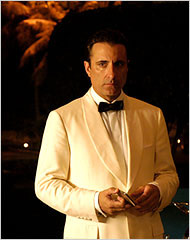 |
 |
 |
 Entertainment | April 2006 Entertainment | April 2006  
An Elegy for Old Havana, 'The Lost City' of Glamour and Music
 Stephen Holden - NYTimes Stephen Holden - NYTimes


| | Andy Garcia as a club owner in "The Lost City," which he directed. (Crescent Drive Pictures) |
"The Lost City," Andy Garcia's ode to the Havana of pre-Communist Cuba, is a romantic epic manqué that swoons across the screen for nearly two and a half hours without saying much, beyond that life sure was peachy before Fidel Castro came to town and ruined everything. Mr. Garcia, who emigrated from Cuba to the United States as a boy, is co-producer, director and star of this labor of love, 16 years in the making.

The city's posh pre-revolution nightlife, as imagined by the movie (filmed in the Dominican Republic), looks even more delectable than those 1950's pictures of movie stars dolled up for a night at Ciro's or the Mocambo in Hollywood. The impoverished masses of Cubans who embraced Castro as a liberator appear only in grainy, black-and-white news clips, awkwardly shoehorned into the movie to fill in historical blanks, and in some buffoonish parodies of sour Communist apparatchiks barking orders once Mr. Castro takes over.

The story, briefly: Mr. Garcia's character, Fico Fellove, the oldest of three sons of a distinguished professor, is living high on the hog as the owner of a glamorous Havana nightclub, El Tropico, when the revolution sweeps in. Fico's two younger brothers, Luis (Nestor Carbonell) and Ricardo (Enrique Murciano), fervently embrace the revolution, but Fico predicts the country's destruction under Castro. (Political dialogue in the film is strictly of the junior high school variety.)

With its sumptuous cinematography and flowery dialogue by the Cuban novelist G. Cabrera Infante, who died early last year, "The Lost City" aspires to be a Caribbean "Doctor Zhivago," in which Fico solemnly contemplates the wreckage of history (and the deaths of both brothers) in anger and in sorrow. The sleek, white-tuxedoed Steve Rubell of his time and place, he eventually loses his nightclub and forsakes his homeland, his parents and the love of his life to start over in New York, while obsessively dreaming of the past.

Portraying the movie's Zhivago surrogate (instead of writing poetry, he pecks disconsolately at a piano), Mr. Garcia belongs to the Omar Sharif school of acting. What little emotion he is able to conjure is concentrated in the eyes, which smolder in two modes, fiery or brooding; tears may glisten at the corners but are never spilled.

Because Mr. Garcia can't really act, there is only dead air between the moments of fire and water. The movie's Lara surrogate, Aurora (the staggeringly beautiful model Inés Sastre), is just as wooden. In their star-crossed romance, she remains forever torn between her passion for Fico and her official role as Widow of the Revolution.

The film's best action sequence is a failed raid on the presidential palace. But it pales in comparison to the Cuban section of "The Godfather: Part II," which "The Lost City" self-consciously echoes. In its unwieldy length and pulpy grandiosity, "The Lost City" also echoes a different "Godfather" film, Part III, in which Mr. Garcia played Michael Corleone's protégé, Don Vincent. As that movie does, "The Lost City" lunges back and forth between intimate confrontations and historical events in a clumsy effort to fuse personal and social upheaval. But because its characters pontificate in generalities and aphorisms, they're little more than stick figures with cartoon balloons pasted over their heads.

The oddest contribution to the film is from Bill Murray, who appears as Fico's sardonic sidekick. Identified only as the Writer, the character, an expatriate American comedian who is never at loss for an enigmatic quip, serves as the film's solo Greek chorus. This kind of Brechtian device might work in a novel or onstage, but in a would-be epic film it feels gratingly out of place. Dustin Hoffman appears briefly (and ineffectually) as the gangster Meyer Lansky, a character who has no reason to be in the movie other than to put Mr. Hoffman's name on the marquee.

In its groggy way "The Lost City" holds your attention. Incoherent, but splendidly panoramic and drenched in wonderful Cuban music, it has the texture of a vivid, intoxicating dream that seems to mean something until you wake up and feel it slipping away. All that remains are feelings and impressions connected by a mood.

The film is rated R for violence.

The Lost City - Directed by Andy Garcia; written by G. Cabrera Infante; director of photography, Emmanuel Kadosh; edited by Christopher Cibelli; music by Mr. Garcia; production designer, Waldemar Kalinowski; produced by Frank Mancuso Jr. and Mr. Garcia; released by Magnolia Pictures. Running time: 143 minutes.

WITH: Andy Garcia (Fico Fellove), Bill Murray (the Writer), Inés Sastre (Aurora Fellove), Lorena Feijóo (Leonela), Tomás Milian (Don Federico Fellove), Elizabeth Peña (Miliciana Muñoz), Dustin Hoffman (Meyer Lansky), Millie Perkins (Doña Cecilia Fellove), Enrique Murciano (Ricardo Fellove), Nestor Carbonell (Luis Fellove) and Richard Bradford (Don Donoso Fellove). | 
 | |
 |



